Tangled
Anyone who’s untangled last year’s carelessly-packed Christmas lights can tell you – it’s not an enviable situation. Knotted strings of holiday lights can inspire a certain sense of hopelessness… And with marketing ramping up for the Main Street Electrical Parade in spring 1972, Disney Imagineers found themselves in a tangled knot of Christmas lights of their own… of course, it was less metaphorical and more literal.
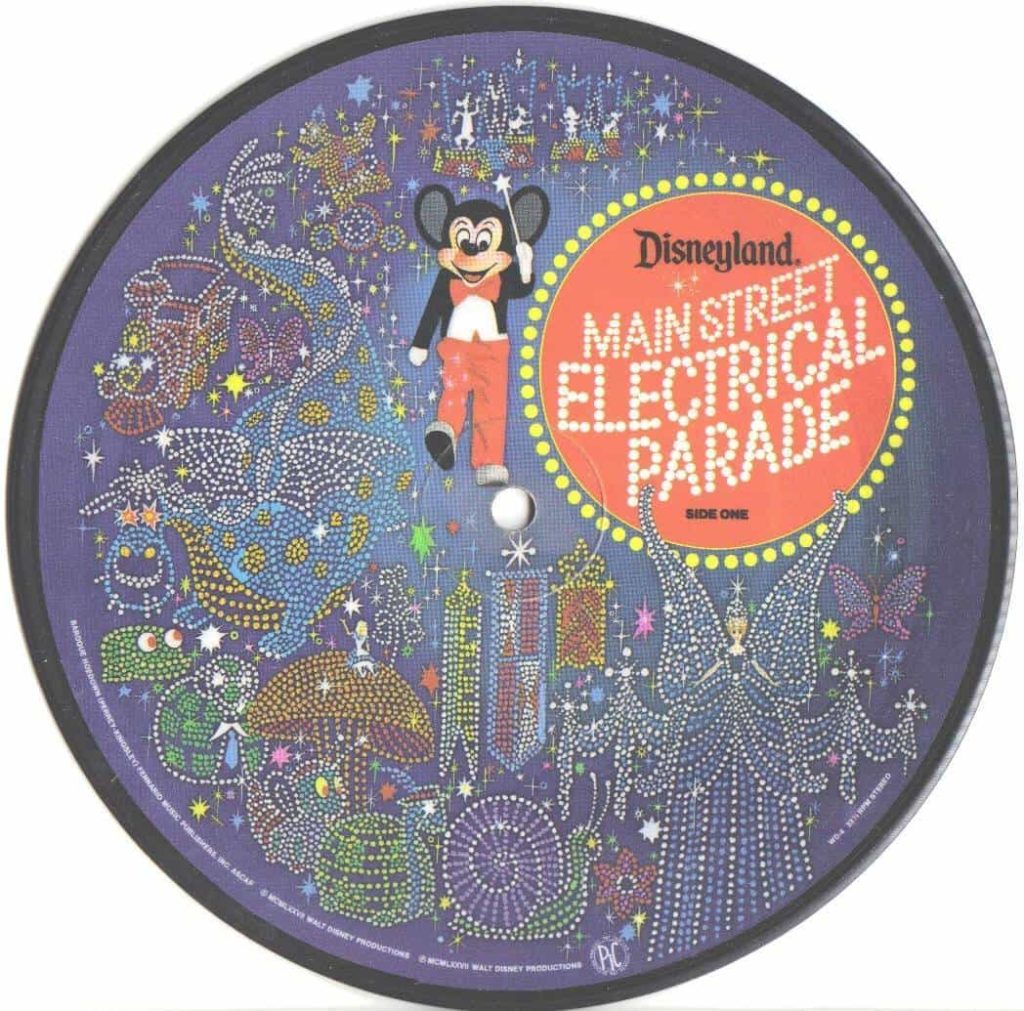
When Director of Show Development Ron Miziker returned to Chicago a few months after the Silvestri Light Company agreed to fabricate the lighted floats for the Main Street Electrical Parade, he was surprised to find… a disaster. “The units were half built. Nothing was done,” he recalled. “You’d look inside the units that were completed and there were these masses of wires coming down, going no where! No labels! It was an absolutely nightmare.”
With two weeks to show time, the team loaded up half-built floats and tangled reams of lights into 14 rental trucks and caravanned back from Illinois to California. There, ’round-the-clock construction crews assembled the floats and – since Silvestri’s patented small lights came only in clear acrylic shells – dipped each of the 500,000 individual lightbulbs into the appropriate dye.
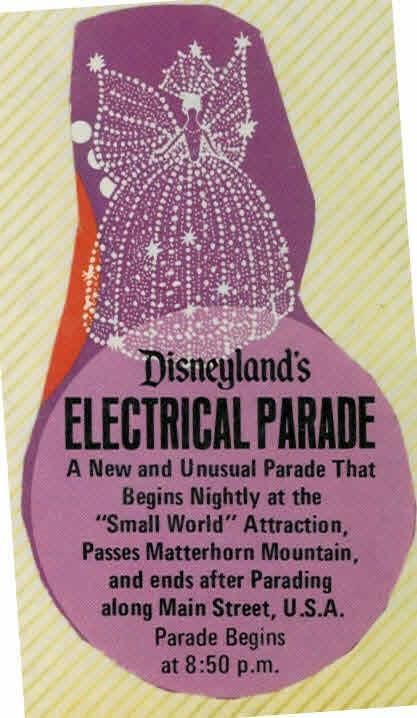
Rushed to the finish line, the Parade didn’t seem quite ready for showtime… Choreographer, director, and (today) Disney Legend Barnette Ricci was given time for just two disastrous dress rehearsals in which, allegedly, a third of the floats were still unfinished; a performer’s costume shot sparks; one float fall apart in the road. Cinderella’s canopy collapsed. Two horses buckled under the weight of a lighted banner they carried. One float even crashed into a building on Main Street. And the Nickel-Cadmium batteries died before the floats even made it to the Matterhorn.
In fact, it’s reported that electricians were furiously wiring the floats until the last seconds before the gates opened on June 17, 1972 for the Parade’s debut performance. As to the sight of electricians jumping off each float just before it rolled on-stage, Miziker remembered, “The sight of that happening was like people jumping ship just prior to it sinking.”
Stake out your spot on the curbs of Main Street, U.S.A… The sun is setting, the electricians are scurrying back to the shadows, and the Main Street Electrical Parade is coming into view…
Disneyland Debut (1972)
If you’d seen the state of the Main Street Electrical Parade’s test runs on June 15, 1972, you may not have expected it to successfully make its official Disneyland debut just two days later. But inexplicably – or perhaps, due to the hard work of hundreds of Cast Members – the parade’s red carpet rollout on June 17, 1972 went off without a hitch.
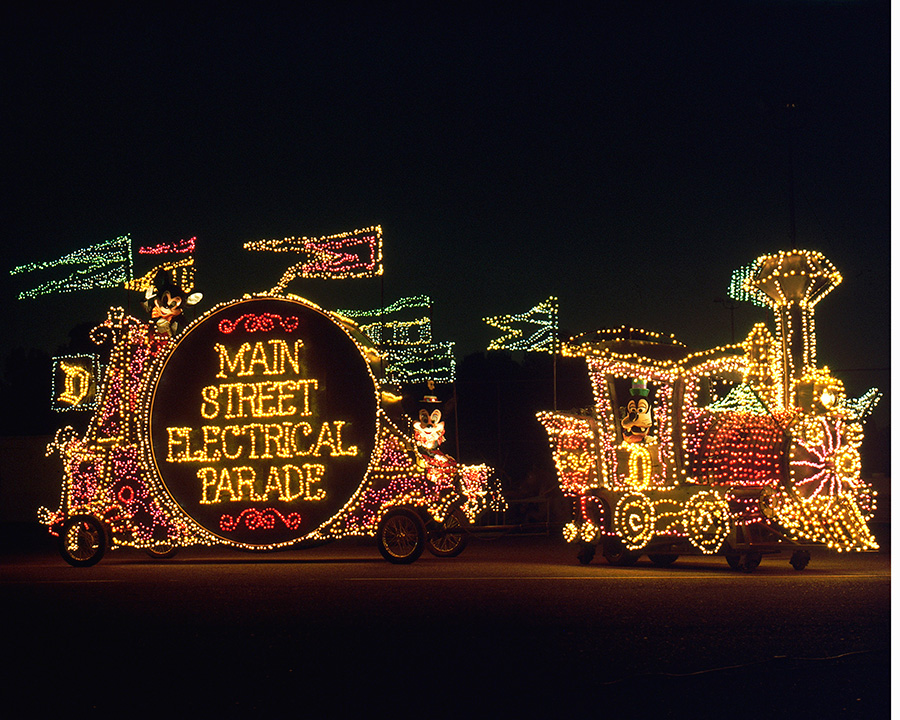
Over 500,000 twinkling lights and 80 performers took to the streets of the park in a coordinated showstopping demonstration of what Disney Imagineering is capable of. To the tune of that same original arrangement of “Baroque Hoedown” borrowed from Orlando’s Water Pageant, the sensational production dazzled and astounded guests.
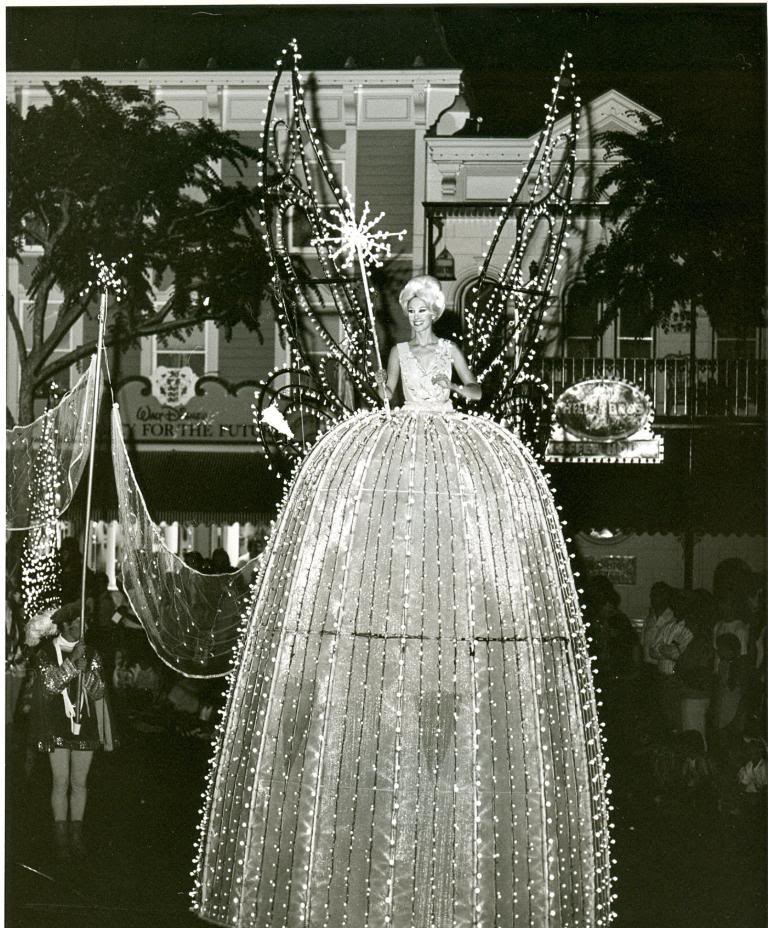
Make no mistake – Disneyland’s official debut of the parade nearly fifty years ago set the stage for generations of Electrical wonder, and many of the show’s key pieces were part of its 1972 California debut.
Along the route, you’d find Mickey, Minnie, and Goofy aboard Casey Jr. and the iconic “drum head” marquee with “fluttering” banners, lit fountains and dancing butterflies, a serpentine Chinese dragon, a circus calliope, glowing ballroom dancers, Alice riding atop a snail, and the beautiful Blue Fairy.

However, while quite a few dimensional floats served as the parade’s central features, many of the 1972 Electrical Parade was actually made of fairly simple flat screens, panels, and two-dimensional wire sculpts (most pushed by hand down the parade route) not unlike the flat floats of the Electrical Water Pageant!
Frankly, the Main Street Electrical Parade was imagined as an entertainment offering solely for the summer of 1972. Its unexpected popularity (and its repeat appeal – of major importance at Disneyland with its heavily regional audience) meant that the parade’s run was extended. It stuck around for over two years, finally “glowing away” after the 1974 holiday season.
That’s because Bob Jani and choreographer Barnette Ricci reunited for another production – America on Parade – to celebrate the United States’ bicentennial. A copy of America on Parade ran simultaneously at Disneyland and Magic Kingdom, respectively, each as both a daytime and nighttime entertainment offering beginning in 1975. Of course, the Electrical Parade wasn’t over. Quite the contrary, its two year hiatus from 1975 to 1977 merely gave Imagineers time to perfect the production… and build two copies of a reimagined (and much more permanent) show.
Rewiring (1977)

In June 1977, the Main Street Electrical Parade returned to Disneyland and hit the road at Magic Kingdom. The two identical copies of the parade (“Version A” and “Version B” respectively) came complete with fully dimensional floats, including the parade’s instantly-recognizable giant mushrooms, nimbly driven dancing snails, the White Rabbit and “walking” centipede of Alice in Wonderland, the Seven Dwarfs, and of course…
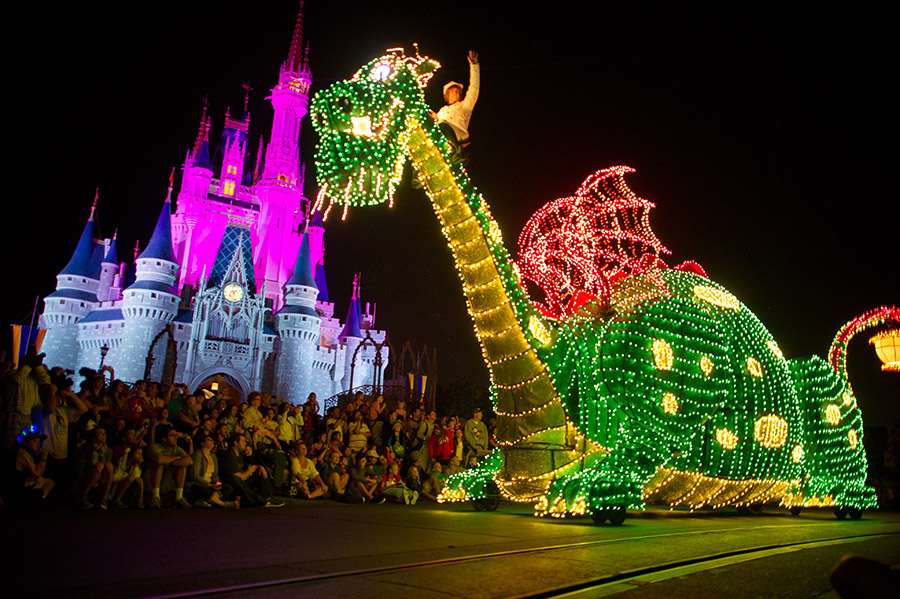
…the iconic Elliot from Pete’s Dragon (initially intended as a single-summer promotional float for Disney’s 1977 film). The incredible show piece – 5,600 pounds, 16-feet tall, 10-feet wide, and 38-feet long – could not only breathe smoke from his nose, but could “disappear” in a blink!
The parade’s original, short-lived finale included rotating mirrors adorned with neon-lit Disney characters (replaced in 1979 with the long-lived “To Honor America” finale flag). Pinocchio floats would also join in 1979; the Seven Dwarfs’ Mine and the Jolly Roger from Peter Pan in 1985; in fact, this version of the Main Street Electrical Parade – with decades of “plusses” throughout its lifetime – is, at its core, the Lost Legend we remember today. A world away from the 1972 original, the 1977 bi-coastal relaunch was a true nighttime spectacle the likes of which Disney parks had never hosted before.
But the new, remixed, reimagined, and still iconic Main Street Electrical Parade didn’t just look different; it sounded different. Yep, it finally happened. For the 1977 relaunch of the built-out parade, its score finally got the sonic refresh that will sound familiar to Disney Parks fans the world over.
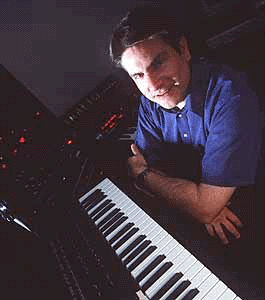
The job fell to the young musician, producer, and audio engineer Don Dorsey, who was tasked with reorchestrating and re-recording the “Baroque Hoedown” theme (rather than merely remixing and looping Perrey & Kingsley’s arrangement as Disney had done for the Water Pageant and original Electrical Parade).
So when you hear the definitive Electrical Parade theme (for Passholders, streaming below), you’re hearing Dorsey’s brilliant from-scratch composition. As Don Dorsey told the Orange County Register, “what makes the music so memorable is its ‘perky, peppy tempo. People can’t help but hum the tune.”

(The song’s original artist, Jean-Jacques Perrey, later stated in Disneyland Paris’ 2005 DVD Explore the Magic: From One Lightbulb To Another, “In the 1970s, Walt Disney Productions chose this tune to be the theme for the Electrical Parade. It was extraordinary, I didn’t know about it because the publishers said nothing to me. It was by chance, in 1980, that I went there and was so surprised to hear “Baroque Hoedown” arranged for a full orchestra.”)
But as any Disney Parks aficianado will tell you, it’s not just that Dorsey’s 1977 version of the Main Street Electrical Parade’s theme song was elevated into the timeless canon of Disney Parks songs; it’s that introdution.
Believe it or not, the Main Street Electrical Parade’s swirling, wobbling, electronic fanfare intro was an innovation in and of itself. Remember those “trigger zones” that would play audio specific to the passing float? Dorsey wanted to take it a step further. As the story goes, he composed the parade’s famous opening fanfare not just to heighten guests’ excitement about the arriving parade, but to try something new.
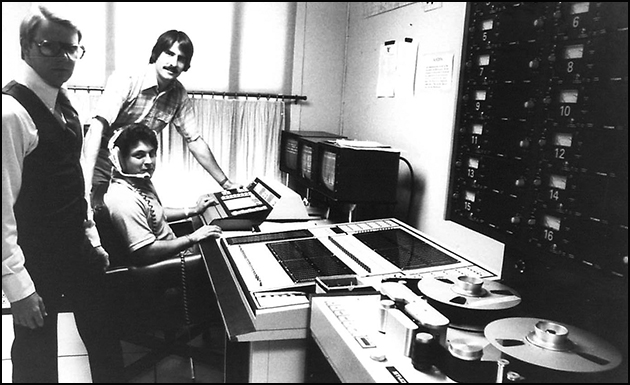
Dorsey wanted to use the parade’s trigger zones and the new opening prologue to synchronize a dramatic “lights out” cue so that at the conclusion of the opening, the entire zone would be instantaneously plunged into darkness – a dramatic, squeal-inducing grand entry for the first floats. In so doing, he invented a production and playback method called the “Opening Window” which has been used to kick off virtually every Disney parade and nighttime spectacular since. (And by the way, it works…! That sudden “light switch” moment elicits cheers every time.)
But we can’t talk about Dorsey’s added opening fanfare without addressing the robotic voice in the room. In 1979, one of the most memorable, beloved, and oft-repeated quotes Disney fans know by heart found its way into Dorsey’s pre-parade fanfare. “Ladies and gentlemen, boys and girls… Disneyland proudly presents our spectacular festival pageant of nighttime magic and imagination in thousands of sparkling lights and electro-syntho-magnetic musical sounds… The Main Street Electrical Parade!”
And who’s the voice behind the line heard by well over a hundred million guests?
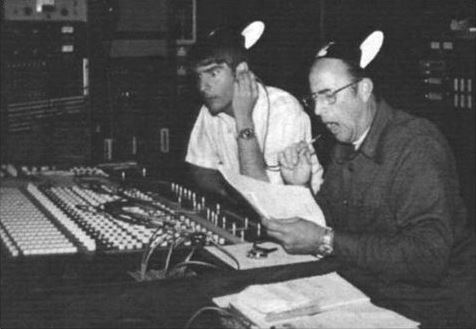
None other than “The Voice of Disneyland” himself, Jack Wagner. Though it may not sound quite like his other in-park announcements, the vocoded delivery indeed stands among his massive catalogue of quotable one-liners and announcements.
And just like that, we’ve finally collected all the ingredient we need… By summer of 1977, the Bicentennial and America on Parade had run their course. With Don Dorsey’s rearrangement (and Jack Wagner’s larger-than-life introduction), the new Main Street Electrical Parade was ready to ride. So find a seat on the curb and settle in as the sun sets…
On the next page, we’ll see the most recognized and revered version of the Main Street Electrical Parade up close, then explore how this spectacular pageant of lights has been reborn time and time and time again in many forms across Disney Parks…. Read on!


